Send Frequency 2021: Exploring Messaging’s Impact on Purchases, Industry by Industry
Published on March 08, 2021/Last edited on March 08, 2021/10 min read
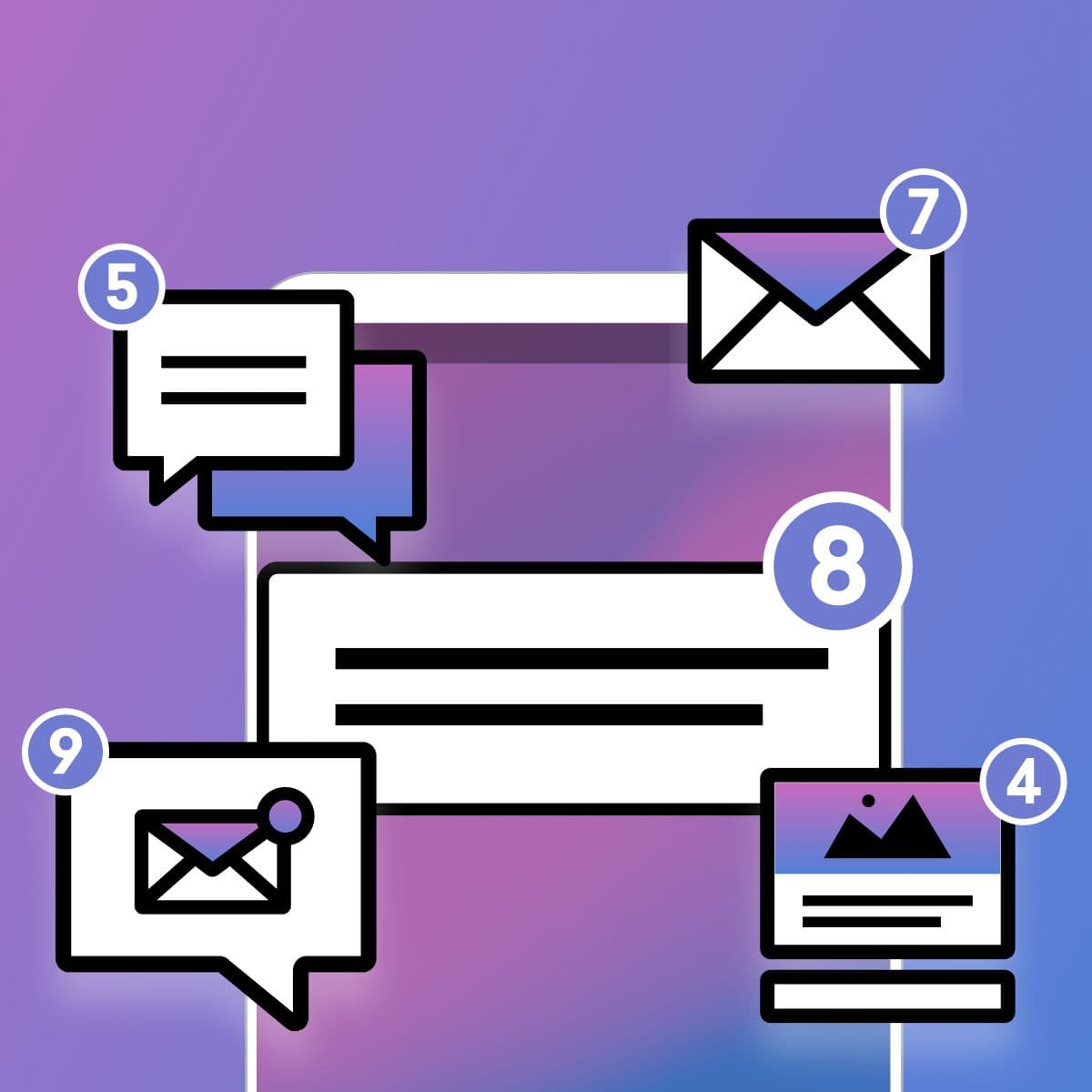

Brendan O'Connor
Customer Insights Analyst, BrazeDuring 2020, Braze sent more than a trillion messages on behalf of customers, giving us a unique window into how send frequency can impact results. In that spirit, we offer these analyses as a starting point for your brand's own frequency testing and optimization work, rather than as a one-size-fits-all optimal benchmark that all brands should match. Remember that many factors can influence frequency, including the use of behavioral and transactional triggers, the segments a given user belongs to (for instance, more engaged customers may be open to more messages), the way a given audience is split within an industry, and the specific messaging strategies a particular brand is using.
We’ve all been there. Receiving 14 emails a day from an ecommerce firm without any self-restraint. Hearing from a favorite brand only once in a blue moon—and then realizing that you’ve missed out on a deal that would have been perfect for you. When companies send messages too rarely or too frequently, it damages the user relationship...but knowing how much is just right can be difficult.
Enter send frequency—which refers to the number of messages a brand sends to a given user over a certain period of time. This concept, which is a subset of marketing pressure, is used to help marketing, growth, and product teams assess whether their messaging cadence is helping or hurting their customer engagement efforts. But many brands struggle to understand how their send frequency stacks up to industry benchmarks.
“How often should we message our users?” is a question we get quite frequently at Braze. To help out, back in 2019 we took a look at the ideal send frequency for push notifications, emails, and cross-channel messages overall. Now we’re back with a look at what ideal send frequency looks like for industries that are primarily focused on purchases.
With all that in mind, we’ll be digging into send frequency for the following industries:
- Deals and Coupons
- Ecommerce
- Retail
- On Demand Business
- Food and Beverage Delivery
- Ridesharing
- QSR/Restaurants
- Automotive
- Business Services
1. Retail and Ecommerce
It’s no secret that customer messaging is a core tool for brands in the retail ecommerce space—odds are, there’s an email in your inbox (or a push in your notification center) right now letting you know about items on sale. But that focus on messaging means that finding the right frequency is essential for top performance.
Deals and Coupon Brands: It’s Time to Discount Your Send Frequency, Too!
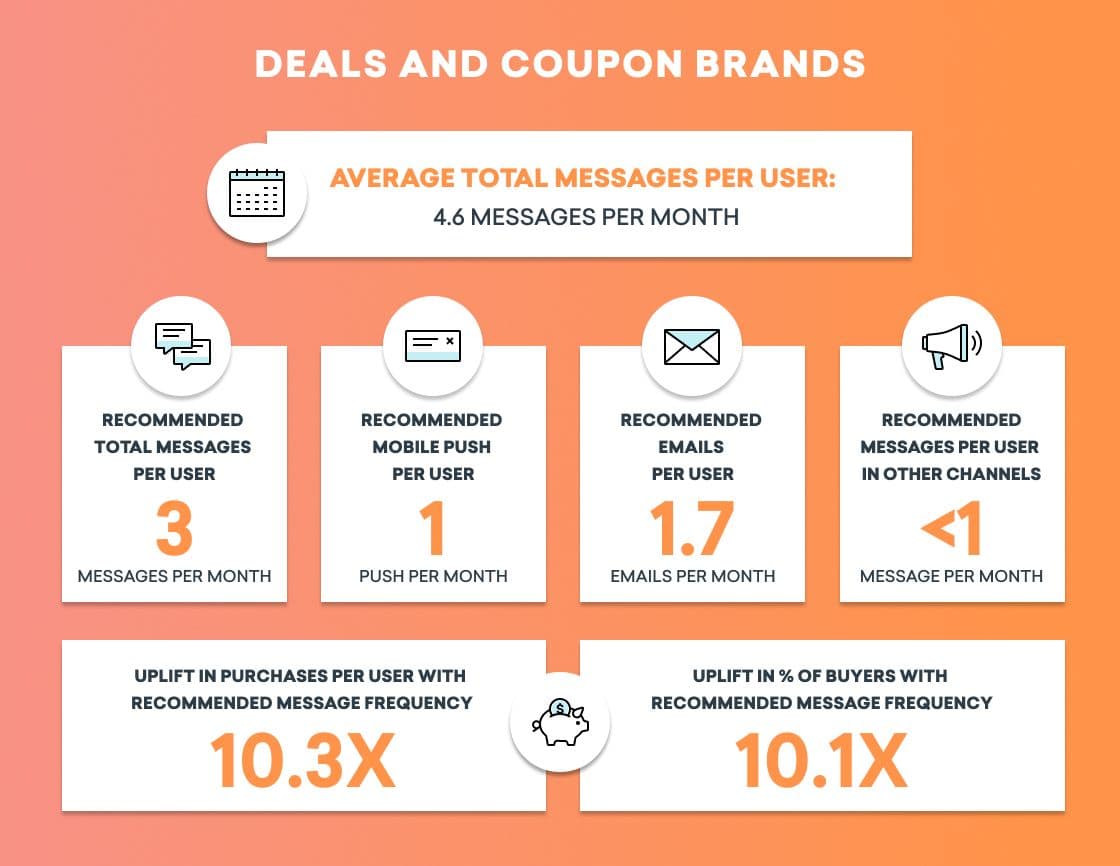
Everyone loves getting a good deal—especially today, as many people look for financial relief in the midst of the COVID-19 pandemic. That’s a boon for deals and coupon brands, but it’s also possible to have too much of a good thing. Our analysis found that when marketers in this space overdo it on outreach, the number of actual purchases they influence tends to suffer.
Deals and coupon brands that sent about three messages per month—which is 40% lower than the industry average for send frequency—saw stronger customer purchase behavior. Plus, users who received the ideal number of messages were 10X more likely to be a buyer and had a purchase frequency that was 10X higher than the industry average. That suggests that sending fewer messages can result in more purchases for companies in this space.
Ecommerce Brands: Growing Fast—But With Room to Grow
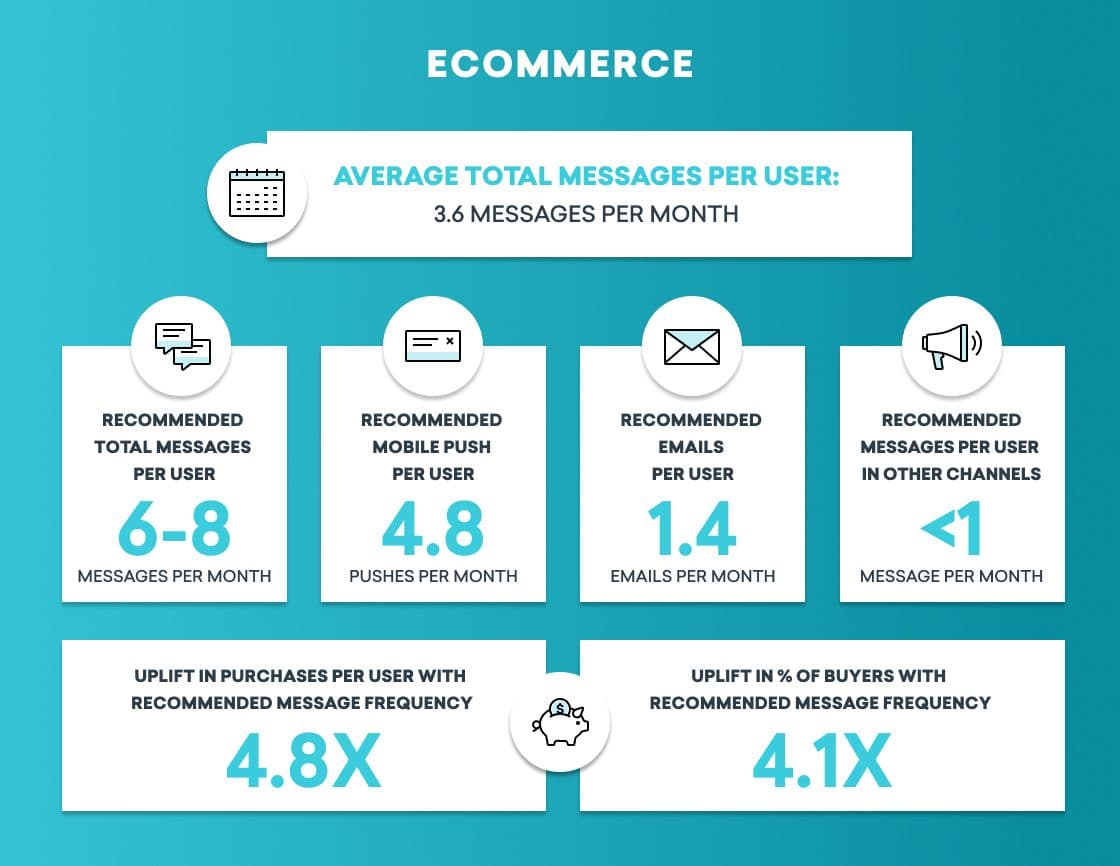
Over the past year, we’ve seen the rise of COVID-19 reshape the business landscape and drive faster digital transformation. That’s especially true in the ecommerce space, which saw massive growth during 2020 as millions of consumers found themselves stuck at home and doing more of their buying online.
But despite this major swing to digital, it turns out that there’s still room for additional growth! Our data found that ecommerce brands that sent between six and eight messages per month saw nearly 5X more purchases per user, and boosted conversion rates on purchase behavior. So if you’re in the ecommerce space, consider adjusting your messaging frequency to bolster your monetization efforts.
Retail Brands: Lean into Message Channel Diversity

As with ecommerce, many traditional retailers found themselves forced to reinvent and reimagine their customer engagement as a result of the pandemic. But brands in this space may need to dream a bit bigger when it comes to message frequency and channel combinations.
Our analysis found that the average retail brand only sends 1.7 messages per user each month, but that the most successful firms in the space sent between two and seven. At that recommended cadence, users are 3.8x more likely to be buyers and see 3.9x higher purchases per buyer. While the average customer in this tier focused primarily on email and mobile push, many brands found additional success by utilizing other channels. Given the wider range of this tier, consider trying out Braze Intelligent Channel to make sure that you’re sending outreach in the channels that speak to each recipient.
2. On Demand
Without timely messaging, on demand just doesn’t work. Brands need to let consumers know when orders and bookings are ready or deliveries are on their way and users need the peace of mind that comes with value-add, in-the-moment outreach. But finding the right mix of messages is an enduring challenge.
On Demand Business Brands: Slow and Steady Wins the Race
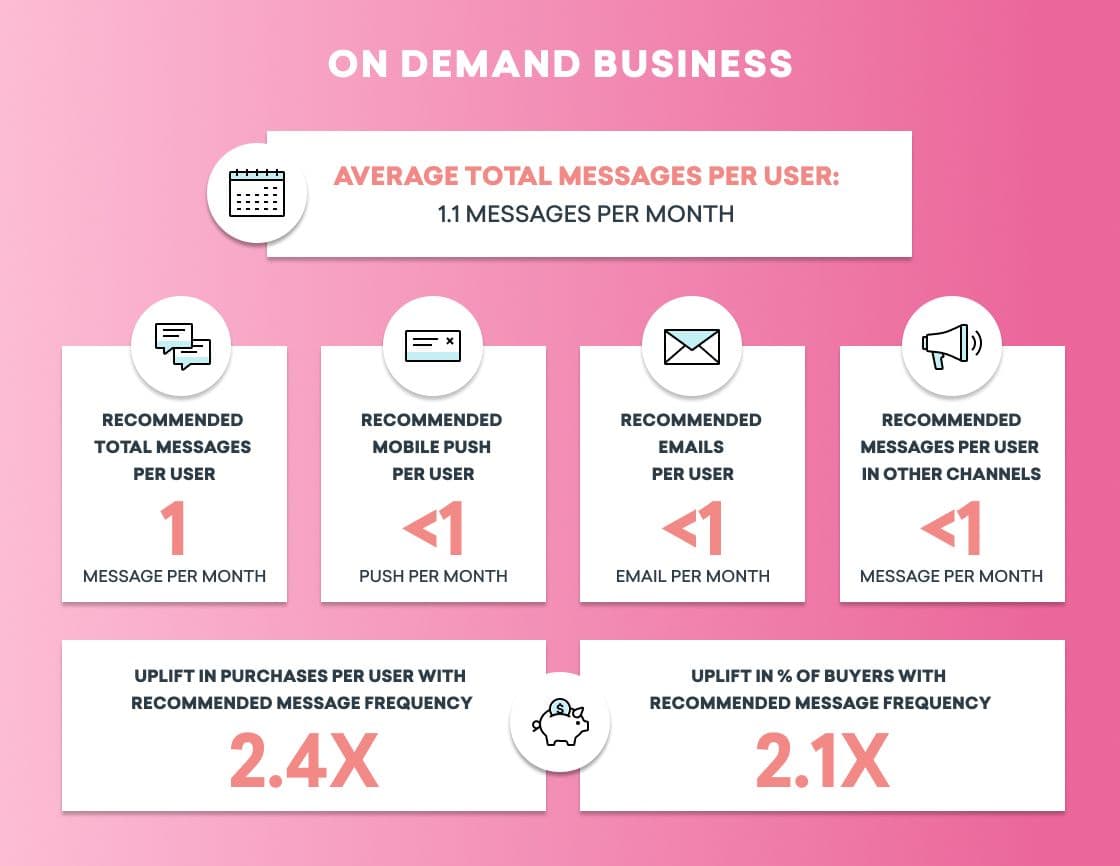
The gig economy has taken off over the past decade. We've seen a growing number of on demand brands leveraging digital platforms to connect customers with quick, reliable service providers across a wide range of industries. But while these brands are known for their swift responses, when it comes to messages, slow and steady may actually be best.
Our analysis found that brands in the space who drove the most customer purchases sent about one message per month, about 10% less than the average for on demand business brands. These companies saw a 2.4X uplift in purchases per user, suggesting that keeping their send frequency low and consistent actually encouraged customers to come back and make that new booking.
Food and Beverage Delivery Brands: The Hungry and the Ravenous
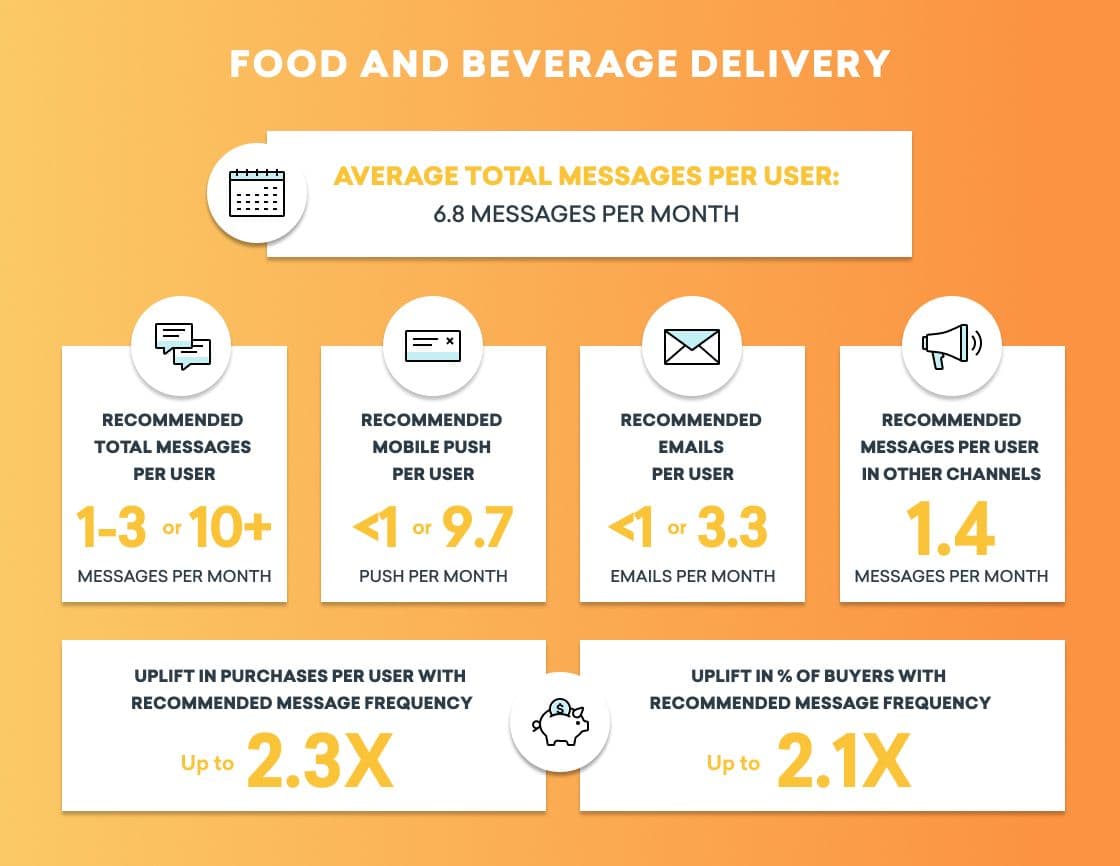
If you’re like most people, the on demand food and beverage delivery vertical has been an essential part of your life since COVID-19 hit, with an enormous number of people turning to food delivery in response to lockdowns and rising health and safety risks. But not every person ordering delivery comes at it the same way.
In fact, we found a fascinating trend when looking into message frequency in this space—namely, we discovered there are two large groups of food and beverage delivery customers that each have their own ideal send frequency. For most users, receiving between one and three total messages per month sees the strongest results; for instance, individuals are 20% more likely to be a buyer and see a boost in conversion rates.
However, there’s another subset of users who have clearly given up on cooking and are getting nearly all of their food delivered! A subset of users who receive more than 10 messages per month see purchase per buyer rates that are 2.3X higher than average and are nearly twice as likely to be buyers. The upshot? Make sure to pay attention to your users who simply can’t get enough, and let it rip on the messaging for that segment! (Just be sure to send them some extra napkins.)
Ridesharing Brands: Let It Ride
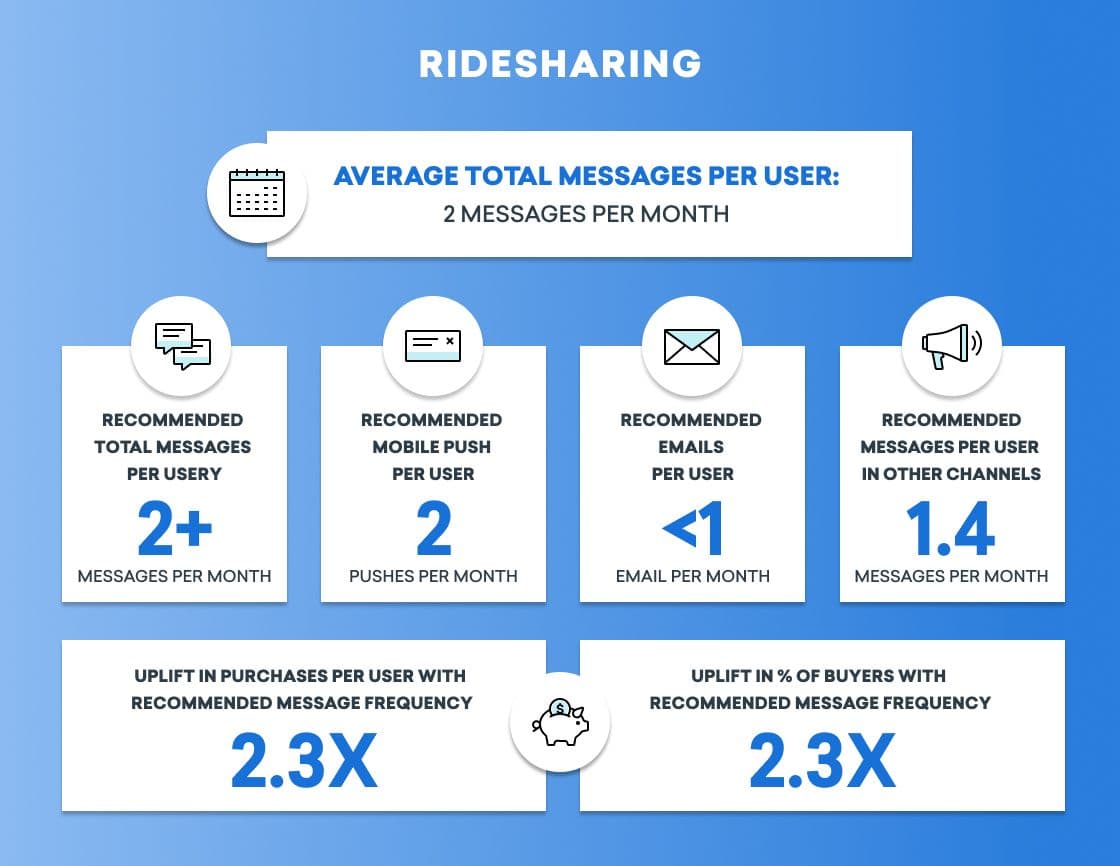
While anyone who’s used a ridesharing service has probably received a “Ride’s Here!” notification, we found that this vertical actually has a pretty low average send frequency, with most users receiving only about two messages per month. That low frequency, however, may be a bit of a missed opportunity—our analysis found that users who received more than two messages per month were actually much more likely to complete a purchase.
On average, the ideal frequency was 3.9 monthly messages, but we also found that some users maximized purchases when they received more than 10 messages per month! Users who received more than two messages each month had a purchase rate 2.3x higher than average and were 2.3x more likely to be a buyer. That suggests that brands in this space should consider upping their messaging frequency when it comes to their most loyal users in order to see stronger bookings.
QSR/Restaurant Brands: Perfect Portion of Messages
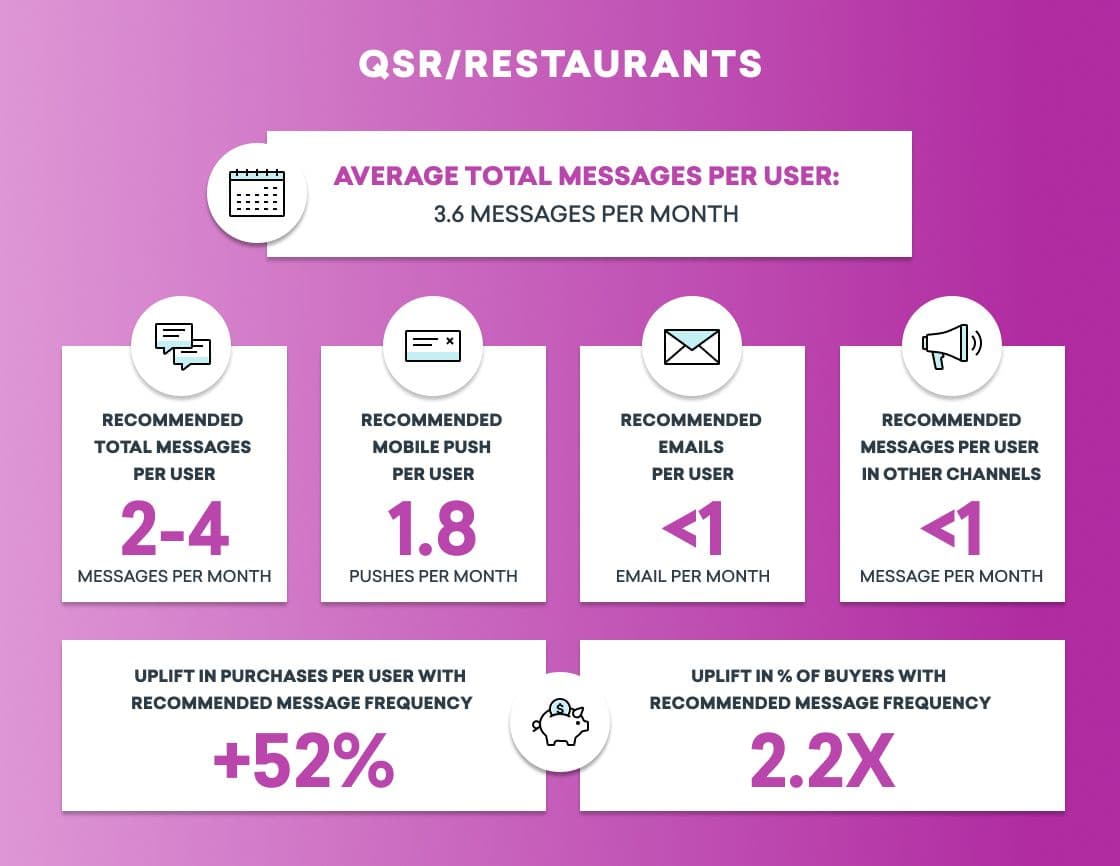
Many brands in the restaurant industry are struggling right now due to the effects of COVID-19, but they’re shining when it comes to message frequency, serving up a perfect balanced meal of outreach. Our analysis found that no other industry had an average send frequency that so closely matched the recommended range, reinforcing that companies in this space are generally doing a great job when it comes to communicating with their customers.
We found that QSR and restaurant brands that send between two and four messages per month really hit the sweet spot, with users in this segment 52% more likely to be buyers and making purchases 2.2X more often. While there’s room to adjust that cadence up or down a bit based on your brand’s individual situation and needs, this is a situation where staying where you are might be the best course of action.
3. Other
While the retail and on demand spaces are known for their focus on driving purchases, they’re not the only verticals where getting customers to buy is objective number one. In our analysis, we also looked at a range of other industries where messaging is focused on driving that next purchase.
Automotive Brands: Stay in Second Gear
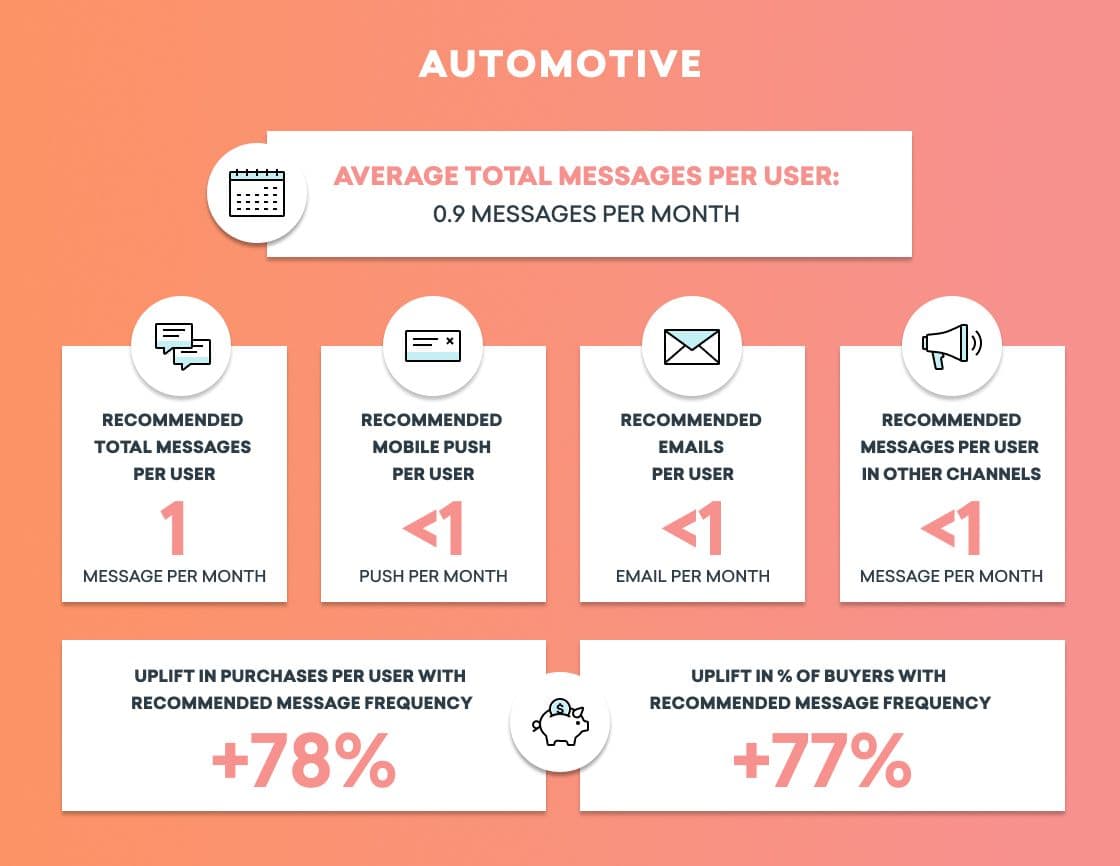
While today’s automotive buyer makes decisions faster than in the past, the purchase journey for this industry is still a lot slower than the buying cycle you see with mobile gaming, for instance. That makes it important for automotive brands to pace their messaging, driving awareness and engagement without overwhelming the customers they’re looking to reach.
Our analysis found that these brands are already mostly getting their send frequency right, with only a small gap between their average send frequency of 0.9 monthly messages and our recommended rate of 1 message per month. For brands who aren’t yet in that sweet spot, adjusting their cadence to that ideal range can drive 78% higher purchases per buyer and make recipients 77% more likely to be a buyer.
Business Services Brands: Running Just a Little Hot
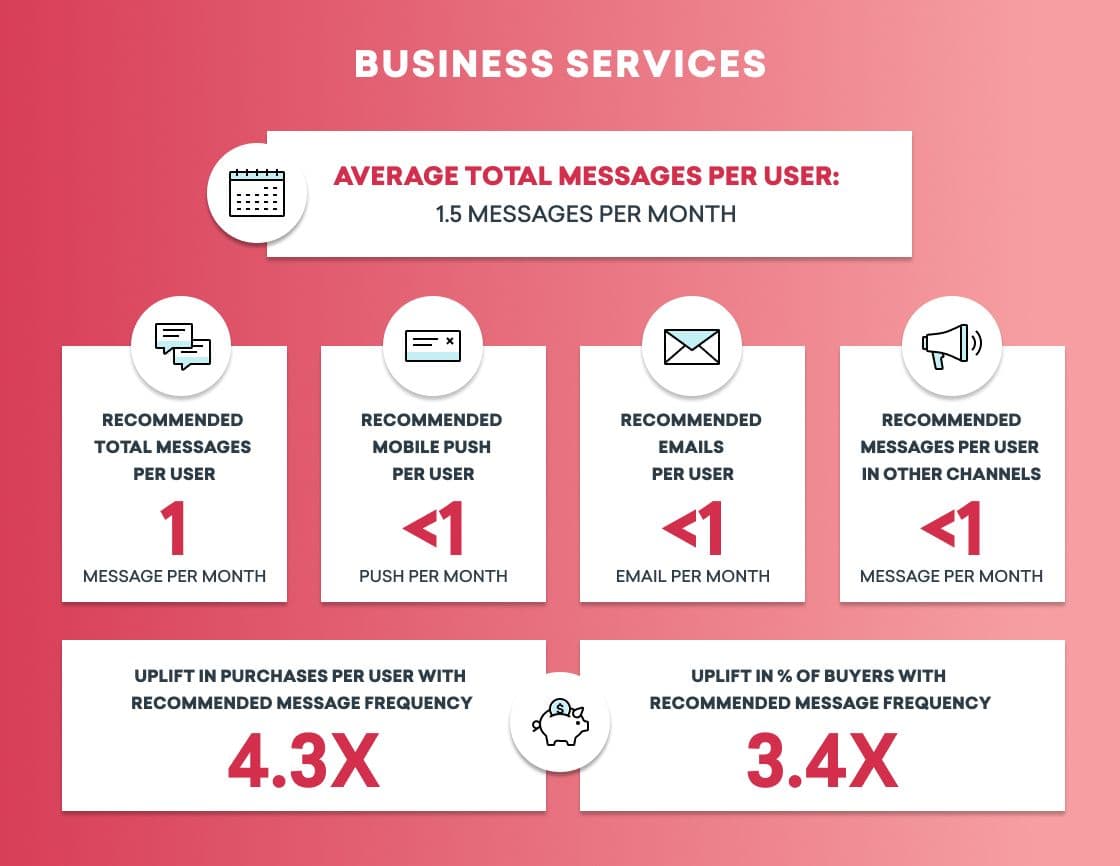
When it comes to send frequency, even small tweaks to how often you send outreach—and in what channels—can pay major dividends when it comes to driving purchases. That’s particularly true in the business services space, where low average monthly send volumes mean that dropping send frequency by just half-a-message each month can lead to a jump in that messaging’s ability to encourage purchases.
Our analysis found that users who receive 1 message per month—rather than the current industry average of 1.5 monthly messages—were 2.5X more likely to be a buyer and had a purchase frequency that’s 3.3X higher than average. The upshot? Sending fewer messages can translate into more purchases, in this vertical, anyway.
Final Thoughts
Data is at the core of effective customer engagement. And with these insights in hand, you’re well-positioned to work wonders when it comes to improving your users’ purchasing behavior in the coming year.
But as you get to work, keep in mind that this analysis focused exclusively on purchase-related metrics, and that over-optimizing on purchases has the potential to create ripple effects that could affect other performance indicators. Keep a close eye on performance, test different send frequencies with different audience segments, and don’t lose sight of the fact that every user—and every audience—is unique.
Interested in learning more about average message performance? Check out our interactive Braze Benchmarks feature to dig deeper into key engagement metrics.
Related Tags
Be Absolutely Engaging.™
Sign up for regular updates from Braze.
Related Content
View the Blog
How AI Decisioning Transforms Marketing (A Complete Guide)

Team Braze

AI decisioning cheat sheet: How to crawl/walk/run with BrazeAI Decisioning Studioᵀᴹ

Team Braze

A day in the life of a data scientist on the BrazeAIᵀᴹ forward-deployed engineering team
